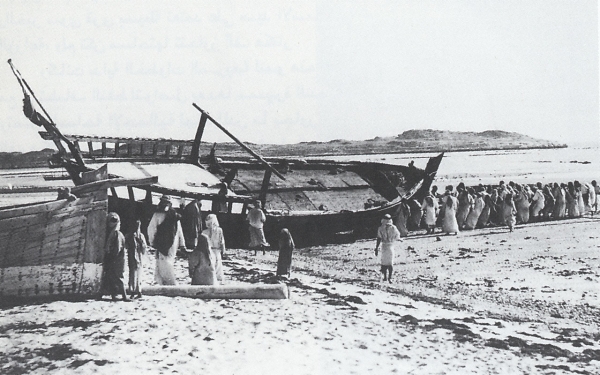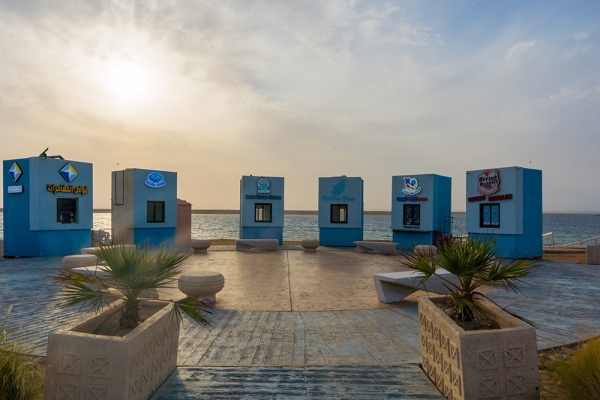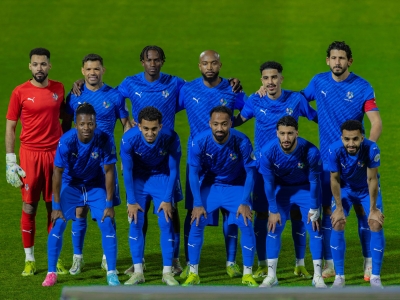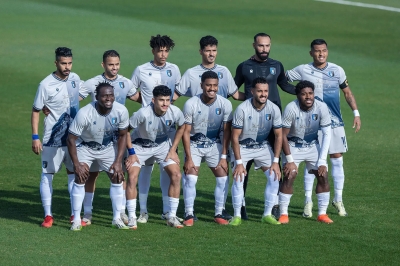

Diving in the Kingdom of Saudi Arabia is a heritage linked to the profession of pearl diving and its trade, which thrived until the 1930s. It is also a sport practiced by Saudis and a promising tourism sector in the Kingdom, particularly in its coastal areas, whether on the Red Sea or the Arabian Gulf.
Pearl diving in Saudi Arabia
Pearl diving is an ancient heritage in the coastal areas of the Kingdom, both in the east along the Arabian Gulf and in the west along the Red Sea. The yield from pearl diving was exported to Gulf countries, then to East Asia and Europe. The pearl trade contributed to the prosperity of commercial and economic activity in the divers' provinces before declining with the emergence of cultured pearls, becoming part of the heritage.
Pearl diving on the eastern coast
Diving trips in the Arabian Gulf usually start in spring, commonly referred to as "ad-Dasha." They begin with a short trip lasting thirty days, known as "al-Khanjiya," followed by the main diving season, called "al-Ghaws al-Oud al-Kabir" (the great dive), also referred to as "ar-Rukba," which lasts for 130 days. The end of the season, when the diving ships return to the shores, is called "al-Qaffal," marked by a celebration to rejoice in the return of those who had been away for more than four months.
The ships return collectively during "al-Qaffal," with the return date determined in agreement with the leader of the divers, known as "as-Sirdal," who is responsible for all the ships participating in the season. This date is officially announced by firing cannons to signal the end of the season and the return. The ships, scattered across the "Heyrat" (diving sites) in the Gulf, gather and head toward the shore with their flags raised.
Pearl diving trips are led by the "Tawash," a pearl trader who moves between diving ships in search of pearls. He is responsible for the crew aboard the ship and determines the duration of their stay at sea.
The diver descends into the sea for two minutes, tied to a rope with a weight at the end to help him dive quickly, a process called "Zaybal." Around his waist, he is secured with another rope hanging from the ship, known as the "Seeb." The diver uses the rope to signal the completion of the task, allowing him to be pulled up quickly. Divers dive to depths that may reach up to eighteen m.
Among the names of pearls in the Arabian Gulf are: "ad-Dana," "Hasbah," and the precious "as-Sahtit." The weight of pearls is measured in Mithqal using a highly sensitive scale. Additionally, small bowls are used, along with sieves, strainers, or measuring tools, which pearl traders utilize to determine the size, weight, and value of the pearls.
Pearl diving in Farasan Islands
On the Red Sea coast, specifically in Farasan Islands, pearl diving trips typically begin in early May and continue for three to four months during the summer, when finding pearls becomes easier. Each ship would carry between thirty and forty individuals, including the captain, divers, sailors, and a navigator. The ship is provisioned with enough food for the journey and potable drinking water.
The ships head to the "maghasat" (diving sites), where oysters, known as "Balbeel", contain pearls. They begin the deep-sea journey by dividing the diving operations over five days, with the yield from the first four days belonging to the diver and the fifth to the shipowner. Diving begins daily at dawn and continues until noon.
The diver uses the "Jalilah," a weight tied to their foot to help them descend to depths sometimes exceeding twelve m. The diver communicates with their assistant on the ship's surface using a rope between them, which the assistant uses to pull the diver back to the surface. The diver allocates a portion of the catch, called "Dangeel," a net used to collect oysters, as payment for the assistant responsible for pulling them up. The process of "opening the balbeel (oysters)" begins in the afternoon.
Merchants use tools to sort large pearls from small ones, including copper sieves called "Gharabeel," which come in seven sizes with varying measurements. They also use scales and other units of measurement. Pearls are classified based on size and weight, with some being perfectly shaped, round, and possessing a brilliant luster without flaws, heavier in weight, and referred to as "ad-Dana." Smaller types include "al-Mazouri," "Ansar," and "Badlah," which have irregular shapes.
Singing arts associated with pearl diving
Pearl diving journeys gave rise to singing arts that helped alleviate the hardship, exhaustion, and dangers accompanying these trips, providing entertainment for the divers. This task on the ships of divers along the eastern coast is carried out by a person called the "Naham," a singer who performs chants after sunset to entertain the sailors until they fall asleep on the ship's deck. The Naham sings Mawwals, hymns, preludes, prayers, and supplications, known as "an-Nahma," without using musical instruments. The chants or "Nahamat" vary based on the tasks aboard the ship. The Naham sings Nahamat throughout all stages of the diving journey, including chants for preparing the ship with the necessary tools, raising the sail, diving, pulling ropes for the diver, and lifting sailors from the depths, such as "Yallah Yallah." During rowing, chants like "Ho Yamal" are performed, along with special Nahamat for the divers' rest time on the ship's deck. The Naham is distinguished by their ability to memorize, their melodious and powerful voice, which instills enthusiasm in the divers.
Among the Naham’s chants is "Ya Mal," performed to express the divers’ feelings of sadness from being away from their families and loved ones, as well as their longing and eagerness to reunite with them. Additionally, there is the rhythmic chant "al-Khatfa," performed while raising the ship’s sails for departure, and "al-Haddadi" chant, sung by the Naham and sailors after completing a dive to create a cheerful atmosphere.
The diving season concludes with "al-Qaffal," which is the "Sailors’ Festival," during which maritime chants and "Ya Mal" are performed aboard the ships. Enthusiasm rises among the divers as other ships join them to return together to the shore. As they approach the coastline, the sails are lowered, and the divers sing chants, while elders, children, and women line the shore, echoing welcoming melodies.
Other arts also emerged along the shores of the Eastern Province, such as "al-Fijri," which consists of: "al-Adasani," "al-Bahri," "al-Makhloufi," "al-Haddadi," and "al-Hassawi." These arts are performed in the traditional gathering places of divers along the coast, during "Dasha al-Bahr" as the ships set sail, as well as the "Nahma" songs performed during diving, including "al-Mijdaf," "al-Kharab," "al-Buraikha," and "al-Shiraa." These maritime arts feature distinct rhythms and are performed in sequence, starting with al-Bahri and transitioning to al-Hassawi. There are five types, beginning on the shore and continuing into the sea during diving, with variations in music and vocal tones for each art form.
The situation is not much different in the Red Sea, where divers created an art form to entertain themselves, break the monotony and hardship, and express their longing to return home and reunite with loved ones. This gave rise to the art of "ad-Danah," one of the traditional arts in Farasan. The traditional style emerged with the opening line, "Ya Ladana Ya Ladana," expressing the accumulation of longing in the hearts of the divers.
Festivals about pearl diving
The Kingdom, particularly the Eastern Province and Jazan Province, hosts festivals and exhibitions about pearl diving. These are traditional folkloric heritage festivals held with the participation of locals and folkloric bands. Among these festivals is the Eastern Coast Festival, held at King Abdullah Park on the Dammam waterfront and at the northern al-Jubayl Corniche. Jazan Province also hosted the exhibition 'Farasan: Nature and Humanity'.
Diving as a sport in Saudi Arabia
The Saudi Water Sports and Diving Federation organizes and oversees diving activities in the Kingdom. This national institution is dedicated to developing and supporting maritime and diving sports, establishing governing regulations, organizing competitions and training courses, and representing the Kingdom in international and Olympic events.
Services provided by the Saudi Water Sports and Diving Federation
Among the services offered by the Saudi Water Sports and Diving Federation are the issuance of national licenses for professional divers, diving center membership, and player registration. On June 24, 2020, the federation launched a licensing platform for diving centers targeting enthusiasts and practitioners of maritime sports. These regulations aim to regulate diving sports in the Kingdom and advance and develop the industry. Additionally, they promote sustainability and environmental preservation. Additionally, they focus on establishing infrastructure for the sport, encouraging investment in the diving industry, enhancing training quality through strict standards, and creating local job opportunities in various diving fields.
Diving centers in Saudi Arabia
The Kingdom is home to numerous diving centers, located in coastal cities and some inland areas. In Jeddah City, these include Natlus Diving Training Center, Blue Coral Diver, United Diver Center, al-Haddad Scuba, Diving Island, Diving Point, Hope of Spring Diving Center, West Coast Diver, al-Khorayef Diving Center, Dive Holics, Shoreline Company Limited, Scuba Master, JFS, Blue Depth Diver, 17Sixty, Fun Diving, Jeddah Tec Diver, Saudi Scuba, al-Sanbook Marine and Diving Supplies, Descent Diving, Future Experts Academy, al-Salam Diver, Red Sea Divers Company, DivePro Sport Center, Max Deep, Dream Diver, Star Seas Diver, Scuba World Establishment, Seven Heroes Establishment, Diamond Sun for Entertainment - La Plage Beach, Let’s Dive, Ocean Breeze, Giant Stride Diver, and Dive Destination. In Dammam, diving centers include Marjan and Sadaf, Prince Mohammed Bin Fahd University, Dammam Diver Center, and Bateel Diver. In Yanbu, there are diving centers such as Dive Bubbles, Adventure Diver, and Dolphin Diver. In al-Qatif, there is the Divers Island Center and the Hussain Mohammed al-Faran Trading Establishment in Safwa. In Jazan, there is the Jazan Diver Center, while in al-Madinah al-Munawwarah, there is Dive Plan. In al-Wajh, there is al-Wajh Diver Center, as well as Diving Secrets Center and Sand Diver in Riyadh. Al-Qunfudhah Diver Center is located in al-Qunfudhah, with Saihat Divers in Saihat, Dive Nation in al-Khobar, Tabuk Diver Center, and the Sindalah Sports Club in Tabuk.
Diving locations in Saudi Arabia
The Saudi Water Sports and Diving Federation has approved locations for practicing diving in both the Red Sea and the Arabian Gulf. Among the diving sites in the Red Sea are: Sharm Yanbu, Ras al-Khor al-Shamali, South of the Cement Factory, al-Hano Center, the Marine Dock at al-Luqooq Center, South of al-Mukharrif Center, and White Sand Beach in Yanbu Governorate in al-Madinah al-Munawwarah Province. Additionally, there are al-Saraj Center, Petro Rabigh, and al-Ghazlani in Rabigh City in Makkah al-Mukarramah Province; Dhahban Marine Beach, al-Qahaz, opposite Atallah Happy Land Park, Soul, Coco, La Plage, Bahadur, al-Salihiyah, Sheraton, and Southern al-Nawras Resort in Jeddah City in Makkah al-Mukarramah Province; al-Mojermah, Corniche al-Wasqah, and al-Zawaher Estuary in al-Lith City in Makkah al-Mukarramah Province; al-Ward Park, the Sunken Ships at the Southern Corniche, and Ras Muhaysin in al-Qunfudhah City in Makkah al-Mukarramah Province; al-Mahaji Beach (Umq Center) and al-Haridah Beach in al-Qahmah City in Aseer Province; al-Hasees Beach, Ras al-Qarn Beach, al-Hussein Marina, al-Sadeen (Sir), Khutub, Shatha Beach, Dana Beach Resort, and Ras Abu Tawq in Farasan City in Jazan Province.
In the Arabian Gulf, there are several diving sites, including al-Khafji Corniche and al-Amoudah in al-Khafji City; al-Fanateer Beach in al-Jubayl City; al-Aziziyah Beach, al-Murjan Beach, al-Murtafa al-Ramli Beach, al-Mahhar Beach, and al-Amwaj Beach in al-Khobar Governorate; al-Qassar Beach and Dawhat Hama in al-Ahsa Governorate; and al-Nakheel in Dhahran City.
Diving tourism in Makkah al-Mukarramah and al-
Madinah al-Munawwarah Provinces
The Red Sea holds immense potential for a thriving diving tourism industry. Along the shores of Jeddah, diving experiences offer opportunities to witness rare marine life. The Red Sea is home to approximately 1,200 species of fish, 20 percent of which are rare. These include the sailfish, the endangered Napoleon wrasse, also known as the "Queen of Coral Reefs," as well as lionfish, moray eels, bull sharks, silky sharks, clownfish (Nemo), white sharks, goatfish, blue trevallies, "luma" fish characterized by glowing blue spots, and tuna.
Diving enthusiasts visit Abu Tair Island, located southwest of Jeddah, to explore the wreckage of the Greek ship Stavronis, which sank in 1978. The Abu Faramish area features an extensive chain of large coral reefs stretching approximately forty km. It is also home to the wreckage of the ship Ann Ann, which lies at a depth of thirty-two m and sank in 1977.
Jabal al-Lith Island, situated two hundred km south of Jeddah with an area of four km², is one of the most picturesque diving destinations, especially in spring or early summer. The island is one of the largest habitats for whale sharks and is renowned for its crystal-clear waters and white sandy beaches.
The islands of al-Lith Governorate in Makkah al-Mukarramah Province are also among the preferred diving spots. These pristine natural islands boast diverse terrains and hold natural treasures such as mountains and coral reef slopes. Among them is Marmar Island, located approximately 25.4 NM southwest of al-Lith City. Its area is about 1.0 km². It is surrounded by dolphins, which attract diving enthusiasts. Various species of Red Sea turtles also nest there. The island is surrounded by waters exceeding a depth of 350 m. It lies at the foot of a steep coral mountain and features underwater skyscraper-like coral formations.
Yanbu, located in al-Madinah al-Munawwarah Province, is another favorite city for diving enthusiasts due to its stunning coral reefs, particularly in Sharm Yanbu.
Diving tourism in Tabuk Province
In the north, the coastline of Tabuk Province stretches for seven hundred km, making it a key destination for diving enthusiasts and underwater exploration. Its marine environment is rich in biodiversity, encouraging activities such as free diving competitions and underwater photography. The coasts of Haql are distinguished by their clear and pristine waters, as well as an abundance of coral reefs.
Al-Wasl Island in the Gulf of Aqaba, located five hundred m off the coast of Haql Governorate in Tabuk Province, is a popular destination for divers. The island spans an area of 22,000 m². The island is characterized by a variety of coral reefs, some of which are visible above the water, especially during low tide. These include brain coral, table coral, stony coral, staghorn coral, fire coral, and soft coral. Additionally, it is surrounded by diverse marine life, such as grouper, clownfish, trevally, and ornamental fish. Its beach is distinguished by its gradient of colors and crystal-clear turquoise waters, in addition to its moderate climate and low humidity levels.
The depths of the sea in al-Wajh Governorate, located in Tabuk Province, hold natural treasures, coral reefs, a variety of marine creatures, and fish stocks. Al-Wajh is a captivating diving center, catering to both deep diving (scuba) and surface snorkeling. It is a prime destination for underwater adventures, where divers encounter schools of fish, vibrantly colored snails, and various types of mollusks. The area is also known for its soft corals, which are surrounded by thousands of small fish, as well as sea anemones that attract clownfish, sardines, seabream, emperor fish, grouper, leopard coral grouper, and sea cucumbers. The Border Guards in Tabuk Province have designated twelve locations for practicing diving.
Sindalah Island is NEOM’s destination for luxury marine tourism. NEOM signed a cooperation agreement with Dive Butler International to offer diving experiences and aquatic adventures for visitors. Dive Butler manages a five-star diving center on the island, accredited by the Professional Association of Diving Instructors (PADI). The center provides activities to explore Sindalah’s marine environment, including diving, sunset cruises, and exploration of more than one hundred sites. Sindalah is home to over 1,100 species of marine life, 15 percent of which are endemic to its waters and found nowhere else. Its waters are also a habitat for dugongs, turtles, and dolphins, which are frequently observed.
The Red Sea Project area is distinguished by its diverse coral reefs, rich marine life, and clear waters, making it a favorite and attractive destination for divers of all levels. These include open-water divers, advanced open-water divers, rescue divers, and dive guides (professional level).
Diving tourism in the southern part of Saudi Arabia
In the south, one of the favored destinations for divers in the Red Sea is the Farasan Archipelago, located off the coast of Jazan Province. Its coral depths, teeming with colorful fish, captivate diving enthusiasts. The waters of the archipelago are home to more than 230 species of fish, as well as endangered wildlife, including green turtles, hawksbill turtles, dugongs, dolphins, certain species of whales, and sharks. Among the favorite diving destinations in the Farasan Islands are the beaches of Sir and al-Hasees, as well as the islands of Damsak and Gumah, with depths reaching up to thirty m.
Related quizzes
Related articles


